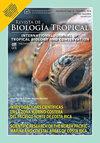恒河流域近危鱼类丽塔丽塔的年龄和生长评价
IF 0.6
4区 生物学
Q4 BIOLOGY
引用次数: 1
摘要
简介:Rita Rita是一种濒临灭绝的淡水鲶鱼,主要是由于失去了繁殖地和哺乳场。渔业管理人员需要一种可靠的年龄和生长估计方法。目的:确定用于年龄和生长评估的最佳身体结构。方法:我们根据分别分析每个钙化结构的读者之间的平均百分比误差(APE)、系数变化(CV)和百分比一致性(PA)来评估估计精度。2018年9月至2019年8月,我们使用了来自恒河、亚穆纳河和拉姆甘加河三条河流的390个鱼类样本。结果:这三个指标有利于使用椎骨进行年龄估计;生长带似乎是每年的,形成于5月至9月。恒河的生长方程为Lt=90.19(1-e-0.145(t+0.51));亚穆纳的Lt=91.19(1-e-0.14(t+0.59)),拉姆甘加的Lt=89.63(1-e-0.15(t+0.68))。结论:该物种在这些河流中生长适度,脊椎是建议的年龄估计结构,在需要的情况下,其次是切片耳石、完整耳石和盖骨。应避免胸脯棘,尤其是年龄较大的鱼类。本文章由计算机程序翻译,如有差异,请以英文原文为准。
Age and growth assessment of the near-threatened fish Rita rita (Siluriformes: Bagridae) in the Ganges basin
Introduction: Rita rita is a freshwater catfish under threat of extinction, mainly from loss of breeding and nursing grounds. A reliable method for age and growth estimation is needed by fishery managers. Objective: To identify the best body structure for age and growth estimation. Methods: We assessed estimates precision based on Average Percent Error (APE), Coefficient Variation (CV), and Percent Agreement (PA) between readers separately analyzed each calcified structure. We used 390 fish samples from three rivers, Ganga, Yamuna and Ramganga, from September 2018 to August 2019. Results: The three indicators favored the use of vertebrae for age estimation; the growth band seems to be annual and formed from May to September. The growth equations were Lt = 90.19(1-e-0.145(t+0.51)) for Ganga; Lt = 91.19 (1-e-0.14(t+0.59)) for Yamuna and Lt = 89.63 (1-e-0.15(t+0.68)) for Ramganga. Conclusion: This species reaches moderate growth in these rivers, where vertebrae are the recommended age estimation structure, followed, in case of need, by sectioned otoliths, whole otoliths and opercular bones. Pectoral spines should be avoided, especially in older fish.
求助全文
通过发布文献求助,成功后即可免费获取论文全文。
去求助
来源期刊

Revista De Biologia Tropical
生物-生物学
CiteScore
1.80
自引率
0.00%
发文量
23
审稿时长
4-8 weeks
期刊介绍:
The Revista de Biología Tropical / International Journal of Tropical Biology and Conservation is a mainstream scientific journal published since 1953 and covered by Web of Science; Science Citation Index; Current Contents; Google Scholar; Scopus, SciELO and nearly 50 additional indices.
A double blind system guarantees you a fair evaluation, and our world class editorial and scientific boards provides a first decision in three working days. The journal is Full Open Access and is widely read where your article can have the highest real impact.
Since its beginning in 1953, the Revista follows these principles: objective and independent evaluation of all manuscripts; transparency in all processes; ethical use of procedures, data, specimens and subjects; fair treatment of all parties; and absolute predominance of scientific rigor over any other aspect.
 求助内容:
求助内容: 应助结果提醒方式:
应助结果提醒方式:


